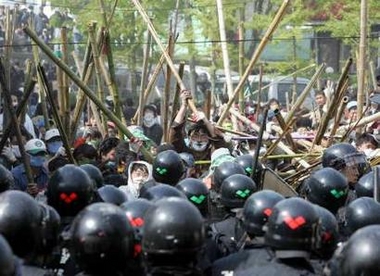The Battle of the Hump, Part 4: The Fiaola Ricefield War
 The lastest example of the Washington Post’s awful Korea coverage is certain to leave you less informed than before you read it.
The lastest example of the Washington Post’s awful Korea coverage is certain to leave you less informed than before you read it.
Anthony Faiola manages to distort the Battle of Camp Humphreys into a conflict between peaceful, bucolic peasants and Uncle Sam’s evil puppet. Faiola apparently found one of the few local residents in attendance — there are just 70 of them among thousands — a sympathetic-sounding 90 year-old woman. It makes a better story to tell it this way than to describe the other 10,000 protestors, who overwhelmingly, are members of radical, pro-North Korean groups like Hanchongryon (which is the suspected to have taken part in some of these assaults on American soldiers) and the Korean Confederation of Trade Unions, infamous for the violence of its protests, including the recent blocking of the U.S. Ambassador on his way to a media interview, and even for beating the mothers of several riot policemen. Faiola says nothing of the violence of the protestors, who brought sharpened bamboo sticks to attack the police. Over 200 people, most of them policemen, were injured in one protest two weeks ago. You can see some of what happened on video here.
Faiola also neglects to mention how Korean government’s inept response made matters much worse than they should have been. The government’s first mistake was its failure to quietly provide sufficient compensation to move the residents away quietly. Perhaps the government meant to use them as pawns in the still unresolved cost-sharing negotiations with the U.S. government. Then, it prohibited the police from using force against the protestors under any circumstances, even though the government knew that the protestors would use violence. When that violence ensued, it sent out the Prime Minister to give a weak-kneed call for both sides to back off. Then, after there was a public outcry over the radicals’ violence, the Korean government made a show of arresting the ringleaders, whose prosecutions it promptly botched. To top it all off, the Defense Minister then publicly threatened to court-martial the civilian protestors, a dubious step for a democracy that never even employed the power of civil authority … at least competently.
Among ordinary Koreans, protests are overwhelmingly unpopular, regardless of the ideological orientation of the pollster. They are also unpopular with local residents. The radicals have even begun to bully and intimidate villagers. To simplify: the locals want to be left alone, which is regrettably no longer an option, and failing that, compensation. The protestors, overwhelmingly, want Juche for everyone.
When I was in Korea three weeks ago, I saw entire neighborhoods of vacated houses that are being demolished for new high-rise housing. There is nothing about this that’s uniquely a problem of meanie U.S. imperialists. No matter how much you may sympathize with people who are losing their homes, why not be equally sympathetic to Korean villagers who had to move for Korea’s new high-speed rail line, or the many new shopping malls or housing developments it builds each year? It’s called eminent domain, and it’s controversial in America, too.
The only ones who seem undecided about this are those in charge of this left-wing South Korean government, which is sponsoring the protestors, and how members of the ruling party are even taking a leading role in them. That same government never fails to play the Anti-Americanism card before elections (there’s one coming next week), yet pleads with America to keep its troops in Korea long after the Cold War and South Korea’s economic boom ended the justification for their presence.
That’s what you get when you get your news from people who don’t follow the subject matter closely, but when presented with a chance to publish their biases to the subscribing audience, present a highly selective view of the facts. The Post’s Korea coverage these days is so bad that I’d rather flip through full-page ads by Sun Myung Moon in the Washington Times to get a more accurate picture. It’s why I’m not a subscriber. I submit that a correspondent owes it to his readers to follow the story carefully enough to describe the factual context accurately. Dipping a toe into the water isn’t enough. You must immerse yourself.
Just short of four years ago, I ended a four-year tour with the U.S. Army in South Korea. Part of that time included a short tour at Camp Humphreys, where the air is perfumed with the breeze from the nearby dog and pig farms. I’m all for pulling U.S. troops out of Korea, which has more or less publicly renounced its alliance with the United States and ceased to be a U.S. ally. I suppose that makes Korea a hostile dependent that would rather not pay for its own defense. Yet the Korean government made the decision to plead with the U.S. government to stay, to which end it’s expanding one U.S. Army post so that dozens of others can be removed entirely. Under those circumstances, the South Korean government owes the residents fair compensation. Whether the compensation is fair is not something I know enough to speak of. I do know that it’s up to the Korean government, which has tried to play both sides of this issue, to provide it.
===========================
Some Postscripts:
While the connection between free trade and rock music escapes me, it’s stories like this that demonstrate what an ambassor needs to be in the information age.
===========================
If this sort of thing interests you, the New York Times has an article on the last male heir of Korea’s Yi Dynasty. Another Onishii puff piece to tide you over while Sanger and Brooke do the real reporting.